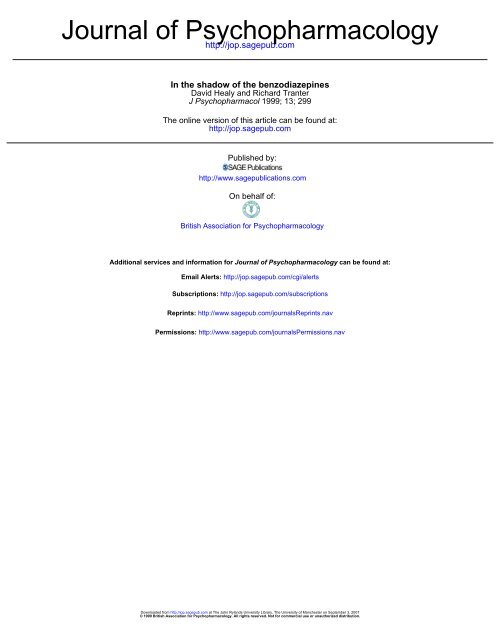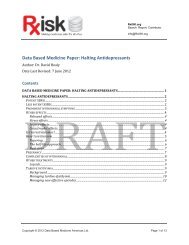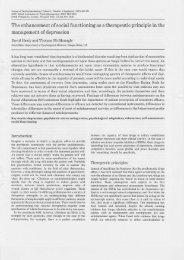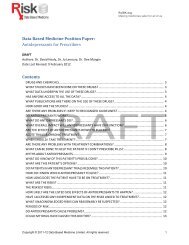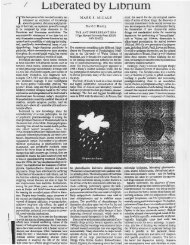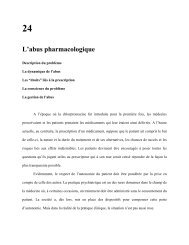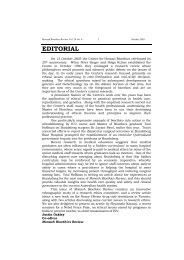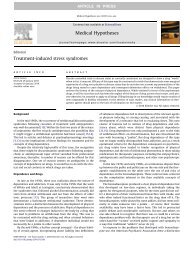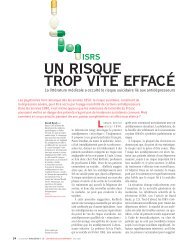In the shadow of the benzodiazepines - Dr. David Healy
In the shadow of the benzodiazepines - Dr. David Healy
In the shadow of the benzodiazepines - Dr. David Healy
Create successful ePaper yourself
Turn your PDF publications into a flip-book with our unique Google optimized e-Paper software.
Journal <strong>of</strong> Psychopharmacology<br />
http://jop.sagepub.com<br />
<strong>In</strong> <strong>the</strong> <strong>shadow</strong> <strong>of</strong> <strong>the</strong> <strong>benzodiazepines</strong><br />
<strong>David</strong> <strong>Healy</strong> and Richard Tranter<br />
J Psychopharmacol 1999; 13; 299<br />
The online version <strong>of</strong> this article can be found at:<br />
http://jop.sagepub.com<br />
Published by:<br />
http://www.sagepublications.com<br />
On behalf <strong>of</strong>:<br />
British Association for Psychopharmacology<br />
Additional services and information for Journal <strong>of</strong> Psychopharmacology can be found at:<br />
Email Alerts: http://jop.sagepub.com/cgi/alerts<br />
Subscriptions: http://jop.sagepub.com/subscriptions<br />
Reprints: http://www.sagepub.com/journalsReprints.nav<br />
Permissions: http://www.sagepub.com/journalsPermissions.nav<br />
Downloaded from http://jop.sagepub.com at The John Rylands University Library, The University <strong>of</strong> Manchester on September 3, 2007<br />
© 1999 British Association for Psychopharmacology. All rights reserved. Not for commercial use or unauthorized distribution.
Journal <strong>of</strong> Psychopharmacology 13(3) (1999) 299<br />
&1999 British Association for Psychopharmacology (ISSN 0269-8811)<br />
SAGE Publications, London, Thousand Oaks, CA and New Delhi<br />
0269-8811 [199905] 13:3; 299; 009371 Response<br />
<strong>In</strong> <strong>the</strong> <strong>shadow</strong> <strong>of</strong> <strong>the</strong> <strong>benzodiazepines</strong><br />
<strong>David</strong> <strong>Healy</strong> and Richard Tranter<br />
NorthWales Department <strong>of</strong> Psychological Medicine, Hergest Unit, Bangor LL57 2PW, UK<br />
We are grateful for <strong>the</strong> lucid commentaries on our critique. It<br />
was dif®cult to argue with any <strong>of</strong> <strong>the</strong> points made but in <strong>the</strong><br />
®nal analysis, while <strong>the</strong>re is a certain amount <strong>of</strong> overlap among<br />
<strong>the</strong> various respondents, <strong>the</strong>y appear to be <strong>of</strong>fering aspects <strong>of</strong> a<br />
multifaceted picture ra<strong>the</strong>r than a model <strong>of</strong> <strong>the</strong> whole, which<br />
leads us back to our original position that a new syn<strong>the</strong>sis is<br />
needed. <strong>In</strong> this, we agree fully with Haddad and Anderson. We<br />
disagree with <strong>the</strong>m and Baldessarini and colleagues when it<br />
comes to <strong>the</strong> question <strong>of</strong> emphasis, namely that <strong>the</strong> problems<br />
<strong>of</strong> discontinuation can be readily managed. Clearly, slow<br />
tapers and speci®c approaches may help many individuals<br />
avoid dif®culties. <strong>In</strong> <strong>the</strong> case <strong>of</strong> neuroleptics, however, for<br />
some individuals at least, it may be effectively impossible to<br />
stop treatment no matter how slow <strong>the</strong> taper and <strong>the</strong><br />
experience may be pure hell.<br />
But <strong>the</strong>re is an entire dimension to <strong>the</strong> issues that <strong>the</strong><br />
respondents seem to have missed. The all but exclusive focus <strong>of</strong><br />
<strong>the</strong> commentaries was on <strong>the</strong> discontinuation period, leaving<br />
largely unaddressed <strong>the</strong> issues raised by <strong>the</strong> emergence <strong>of</strong><br />
syndromes such as tardive dyskinesia in <strong>the</strong> course <strong>of</strong><br />
treatment. We suspect that <strong>the</strong>re are many o<strong>the</strong>r such<br />
syndromes <strong>of</strong> which <strong>the</strong> most pernicious may be tardive<br />
dysthymia. A long-lasting dysthymic syndrome certainly can<br />
occur on neuroleptic discontinuation. We nei<strong>the</strong>r know <strong>the</strong><br />
frequency with which this happens, nor whe<strong>the</strong>r similar to<br />
tardive dyskinesia it may emerge in <strong>the</strong> course <strong>of</strong> treatment.<br />
Why don't we know?<br />
What is <strong>the</strong> research community doing about phenomena<br />
like `poop-out' on selective serotonin reuptake inhibitors<br />
(SSRIs)? This is tardive in onset, probably dysthymic,<br />
occurring in a group <strong>of</strong> drugs that may also produce longlasting<br />
treatment emergent dyskinesias. The phenomenon has<br />
been extensively reported in <strong>In</strong>ternet forums but something<br />
prevents <strong>the</strong> academic community from getting to grips with it.<br />
Serious neuroleptic discontinuation syndromes were extensively<br />
reported in <strong>the</strong> 1960s but <strong>the</strong>n vanished from view, so<br />
that no textbook or review article makes any mention <strong>of</strong> <strong>the</strong>m<br />
for 30 years. Why?<br />
These facts suggest that something about our <strong>the</strong>oretical<br />
preconceptions is inhibiting our ability to see things in front <strong>of</strong><br />
our noses. It may be <strong>the</strong> belief <strong>the</strong>re is something wrong with<br />
<strong>the</strong> 5-HT system in depression or <strong>the</strong> dopamine system in<br />
psychoses blocks our ability to see that <strong>the</strong> SSRIs or<br />
neuroleptics might act more like stressors on brain systems<br />
ra<strong>the</strong>r than replacement <strong>the</strong>rapies like insulin. Or it may be<br />
that linking physical dependence to abuse liability and both to<br />
addiction makes us unable to recognize problems caused by<br />
agents which, despite occasional cases <strong>of</strong> escalating doses, are<br />
simply not `addictive'. Or it may be that a `heroic'<br />
(occasionally cowboy) ethic affects Western <strong>the</strong>rapeutic<br />
practices leading to periodic crises in which a group <strong>of</strong> drugs<br />
such as <strong>the</strong> <strong>benzodiazepines</strong>, which do not cause signi®cant<br />
problems in Japan for instance, end up all but proscribed in<br />
<strong>the</strong> West.<br />
Ashton and colleagues note that <strong>the</strong>re are important issues<br />
concerning what addicts do with drugs. It would seem that<br />
<strong>the</strong>re are also important issues concerning what medical<br />
researchers, pharmaceutical companies and regulators do<br />
with information. If it is a truism that most drugs, even ones<br />
without clear effects on <strong>the</strong> central nervous system (CNS), can<br />
cause tolerance-related phenomena and dependence, why<br />
haven't we collected speci®c data on <strong>the</strong> nature <strong>of</strong> <strong>the</strong><br />
problems caused by each <strong>of</strong> <strong>the</strong> drugs we use in psychopharmacology?<br />
Why did discontinuation syndromes with <strong>the</strong> SSRIs<br />
come as such a surprise? Similar scotomas in <strong>the</strong> case <strong>of</strong> <strong>the</strong><br />
<strong>benzodiazepines</strong> resulted in <strong>the</strong> opprobrium traditionally<br />
heaped on addicts being redirected to medical practitioners,<br />
who had left <strong>the</strong>mselves open to castigation. We deal with a<br />
vulnerable group <strong>of</strong> patients, where treatment emergent<br />
problems are likely to mirror <strong>the</strong> index conditions. This is a<br />
challenge requiring innovative and sensitive science to generate<br />
medicine-based evidence. We have effectively done nothing to<br />
improve our data collection on <strong>the</strong>se issues since <strong>the</strong><br />
benzodiazepine crisis.<br />
This is unfortunate. Negatively, it is unfortunate because we<br />
leave ourselves open to a replay <strong>of</strong> <strong>the</strong> benzodiazepine story<br />
with <strong>the</strong> consequent loss <strong>of</strong> useful drugs. But <strong>the</strong>re is ano<strong>the</strong>r<br />
reason why <strong>the</strong> situation is unfortunate for anyone who is<br />
hopeful for <strong>the</strong> future. While we agree fully with Tyrer that<br />
<strong>the</strong>re are constitutional and personality components to <strong>the</strong><br />
problem, and withdrawal phobia is certainly a real phenomenon,<br />
to focus too much on this aspect <strong>of</strong> <strong>the</strong> problem risks<br />
perpetuating a nihilistic view that sees all drugs as <strong>the</strong> same.<br />
This is simply wrong. All drugs do not cause clinically<br />
signi®cant treatment-induced problems. CNS drugs do not<br />
all cause similar problems. There are strong indications within<br />
<strong>the</strong> group <strong>of</strong> SSRIs and <strong>the</strong> group <strong>of</strong> neuroleptics that not all<br />
compounds cause similar problems. But without <strong>the</strong> data that<br />
establish <strong>the</strong> nature and frequency <strong>of</strong> <strong>the</strong> problems and<br />
differential effects between drugs, we cannot begin to pinpoint<br />
what mechanisms confer protective bene®ts or which patients<br />
are most at risk.<br />
Downloaded from http://jop.sagepub.com at The John Rylands University Library, The University <strong>of</strong> Manchester on September 3, 2007<br />
© 1999 British Association for Psychopharmacology. All rights reserved. Not for commercial use or unauthorized distribution.


